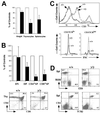Abnormal development of Purkinje cells and lymphocytes in Atm mutant mice
- PMID: 10716718
- PMCID: PMC16240
- DOI: 10.1073/pnas.97.7.3336
Abnormal development of Purkinje cells and lymphocytes in Atm mutant mice
Abstract
Motor incoordination, immune deficiencies, and an increased risk of cancer are the characteristic features of the hereditary disease ataxia-telangiectasia (A-T), which is caused by mutations in the ATM gene. Through gene targeting, we have generated a line of Atm mutant mice, Atm(y/y) mice. In contrast to other Atm mutant mice, Atm(y/y) mice show a lower incidence of thymic lymphoma and survive beyond a few months of age. Atm(y/y) mice exhibit deficits in motor learning indicative of cerebellar dysfunction. Even though we found no gross cerebellar degeneration in older Atm(y/y) animals, ectopic and abnormally differentiated Purkinje cells were apparent in mutant mice of all ages. These findings establish that some neuropathological abnormalities seen in A-T patients also are present in Atm mutant mice. In addition, we report a previously unrecognized effect of Atm deficiency on development or maintenance of CD4(+)8(+) thymocytes. We discuss these findings in the context of the hypothesis that abnormal development of Purkinje cells and lymphocytes contributes to the pathogenesis of A-T.
Figures




References
-
- Gatti R A, Boder E, Vinters H V, Sparkes R S, Norman A, Lange K. Medicine. 1991;70:99–117. - PubMed
-
- Boder E. Kroc Found Ser. 1985;19:1–63. - PubMed
-
- Savitsky K, Bar-Shira A, Gilad S, Rotman G, Ziv Y, Vanagaite L, Tagle D A, Smith S, Uziel T, Sfez S, et al. Science. 1995;268:1749–1753. - PubMed
-
- Banin S, Moyal L, Shieh S, Taya Y, Anderson C W, Chessa L, Smorodinsky N I, Prives C, Reiss Y, Shiloh Y, et al. Science. 1998;281:1674–1677. - PubMed
-
- Canman C E, Lim D S, Cimprich K A, Taya Y, Tamai K, Sakaguchi K, Appella E, Kastan M B, Siliciano J D. Science. 1998;281:1677–1679. - PubMed
Publication types
MeSH terms
Substances
Grants and funding
LinkOut - more resources
Full Text Sources
Other Literature Sources
Medical
Molecular Biology Databases
Research Materials
Miscellaneous

